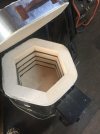I believe that has an analog controller. The dial runs an ON/OFF timer. At 1 it is ON 10% and OFF 90% .... at 9 it is ON 90% and OFF 10%. On HI it is on all the time, and at OFF (zero on some controls) it is off all the time. There is a loud CLICK as the high current relay slams open and closed when heating. It does not measure temperature ... just timing of the power on/off cycle.
IT also probably has a "kiln sitter" which is two rods sticking inside to hold a firing cone. When the cone melts, the rods move and shut off the kiln. Some have a firing timer, too. This runs the firing for a set number of hours and shuts things off. All this is pretty useless for knife HT. Most can be stripped out and the new stuff put in the control box.
You will want to change the controller to a PID for knife HT. There are two ways:
1) Make a separate control unit with a power cord/power switch/PID control/ SSR/heat sink/socket. This will allow the kiln to be plugged into the controlled socket.
Mount the PID stuff in a project box and place near the kiln.
Place a new TC in the forge and connect it to the PID.
Plug the control box into the wall socket, plug the kiln into the controlled socket, turn the kiln power switch to ON, and set the dial to HI.
Turn everything on and off from the PID box power switch.
When the PID is turned on and running, it will control the kiln.
If you want to shut off the coils while moving knives in/out, just flip the Kiln power switch off and then turn it back on when the door is shut again.
Leave the old TC in the kiln, as that will still read on the scale on the kiln.
2)The timer has two AC wires. One in from the main switch, and the other out to the relay. This is the relay control line. There may be other wires, but they shouldn't be needed to convert to PID.
Remove the dial and timer after identifying and tagging these two wires. At this point there should be two main power wires going to the relay/coils and the two relay wires you just identified, plus a couple wires to the red light.
Cut out the box and fit the PID control where you removed the dial ( if it will fit inside the space).
Mount an SSR in the box . If you use a 40 amp SSR and mount it to the box metal with heat sink grease you won't need a heat sink.
Connect AC power to the PID directly from the main switch, and connect a common line to the PID from the power cord common buss.
Wire the PID SSR out +/- wires to the SSR. Connect the SSR #1 and #2 terminals to the two rely control wires you identified earlier that was coming from the timer control.
Run a new TC from the chamber to the TC terminals on the PID. Both will read in use.
When the kiln power switch is turned on, the PID is energized. When the PID is in the RUN mode, it will turn the old relay ON and OFF as needed to control the temperature.
NOTE:
TCs are polarized and any wiring, plugs, and sockets used to connect them must be matching type TC wire. We normally use type K TCs. Figure all this out before hooking up any TC circuits.


